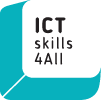
Intellectual Output 3 // Digital Education and E-Learning
Development of materials for online
platform and usability tests
Output Description
O3/A1 – Online platform and training tools
In this intellectual output, an integration of the achievements of the intellectual output O1 will be performed in order to create information, training tools and resource materials for the web platform. The content will be developed taking into attention accessibility for old adults, with the purpose of guaranteeing a greater autonomy to use website content, such as vision, hearing, motor control and cognition. The platform will have general information, as well as simple training tools that can be accessed by the old adults in an autonomous way to improve their digital skills. The training tools will focus on essentials about digital device use, including desktop computer, laptop, tablet or smartphone; basic functions of a keyboard, a mouse and a computer; essential skills to getting started online; essential skills to stay safe online; how to connect with friends and family using social networks; and how to make video calls, using Skype, WhatsApp and Facetime. These tools are innovative as they allow increasing the digital competences in higher number of old adults across Europe without any associated costs. The platform and its content will be released in 5 European languages.
O3/A2 – Perform usability tests of the web platform and online tools with end-users
Purpose: Framed by a user-centred design approach, the ICTSkills4All sets usability tests as an irreplaceable practice to provide input on how real users interact with the system. The inclusion of end-users throughout the R&D process is embedded on a participatory approach and tends to favour the future uptake of the solution, i.e. as usability tests result in recommendations for system’s optimisation, the end point should be a platform adjusted to end-user’s needs and requirements. The general goal of the usability tests for the ICTSkills4All is to identify the extent to which the interface facilitates a user’s ability to complete typical tasks with efficiency, effectiveness and satisfaction. Hence, the tests allow to evaluate the web interface design, information flow, and information architecture. Approach: Three iterations are established as a minimum standard for the ICTSkills4All user tests, which are planned to be implemented in realistic but controlled environments, addressing first the core functionalities of the platform and lastly the complete solution. The first loop of user tests will comprise high-level goals including the assessment of the platform’s ‘look and feel’ appeal; of the extent to which the platform organisation makes it easy to find the information, keep track and predict where information is contained; on how well the platform prevents errors or helps the user to recover from errors; and how pleasant, satisfying and interesting is the user interaction with the platform. The goals for the following loops will rely on the findings from the first loop and implementation of system’s improvements. The usability protocol is designed to capture the participant’s navigational choices, task completion rates and ratings, overall satisfaction rates and ratings, and resource to the techniques of task analysis with think aloud protocol, video analysis and questionnaires. Therefore, objective (e.g. task completion rates) and subjective (e.g. satisfaction) measures are collected. Consenting participants will be recruited by convenience according to pre-defined profiles corresponding to the project’s target groups and, within those profiles, the recruitment of heterogeneous participants regarding demographics and ICT skills (by using a ICT skills questionnaire) will be considered (e.g. to avoid overrepresentation of the so called ‘lead users’). A screening tool tackling demographics and, most importantly, psychographics will be used to screen for eligibility in the recruitment stage. Since it is well accepted that about 15 users are able to detect 90 to 100%, with larger numbers resulting in redundant or saturation of findings, and considering that the performance of smaller user tests in several iterations is the recommended practice (Nielsen, 2000), 6 to 8 users total (i.e. for all countries involved) will be recruited per iteration (18 to 24 users enrolled for the 3 loops). Each individual test session will last approximately one hour and led by a test administrator and a data logger.
Output Type Open / Online / Digital Education; E-Learning course module
Activity Leading Organisation U.Porto & Porto4Ageing
